Design and Validation of a SEPIC-Based Novel Multi-Input DC-DC Converter for Grid-Independent Hybrid Electric Vehicles
Abstract
1. Introduction
2. A SEPIC-Based Novel Multi-Input DC-DC Converter for Grid-Independent Hybrid Electric Vehicles
2.1. Modes of Operation, Dynamic Equations, and State-Space Model
2.1.1. Mode–1
2.1.2. Mode–2
2.1.3. Mode–3
2.1.4. Mode–4
2.2. Average Large-Signal Modeling
2.3. Small-Signal Modeling
2.4. Steady-State Modeling
2.4.1. Effect of Parasitic Elements
2.4.2. Inductor and Capacitor Selection
2.4.3. Condition for DCM
3. Voltage Stress and Efficiency Calculations
3.1. Voltage Stress Calculations
3.2. Efficiency Calculations
4. Possible Operating Scenarios
4.1. Solar PV Panel Alone Supplying the Load
4.2. Fuel Cell Alone Supplying the Load
4.3. Fuel Cell Plus Solar PV Panel Supplying the Load
5. Results Discussion and Analysis
6. Conclusions
- Implement the proposed converter in a GIHEV and design an appropriate controller to produce controlled output.
- Develop a low- and medium-power GIHEV with the help of the proposed converter, a highly efficient and cost-effective fuel cell, and solar PV panel grid-independent-based hybrid energy system.
- Using the proposed converter and artificial intelligence technique, design a low- and medium-power autonomous GIHEV.
Author Contributions
Funding
Institutional Review Board Statement
Informed Consent Statement
Data Availability Statement
Conflicts of Interest
Abbreviations
| GIHEVs | Grid-independent hybrid electric vehicles |
| SEPIC | Single-ended primary-inductor converter |
| MIC | Multi-input DC-DC converter |
| PV | Photovoltaic |
| EVs | Electric vehicles |
| CCM | Continuous conduction mode |
| DCM | Discontinuous conduction mode |
| Four IGBT switches | |
| and | Two diodes |
| and | Large-signal terminal voltages of solar panel and fuel cell, respectively |
| and | Two inductors |
| and | Two capacitors |
| Load resistance | |
| and | Large-signal voltages across and |
| and | Large-signal currents flowing through and |
| and | Large-signal currents flowing through and |
| Large-signal voltage across | |
| Large-signal duty cycles of Mode–1 to Mode–3 | |
| Time period of switching pulse | |
| Switching frequency | |
| Average large-signal model state vector matrix | |
| First derivative of average large-signal model state vector matrix | |
| Average large-signal model input vector matrix | |
| Average large-signal model output vector matrix | |
| Average large-signal model system matrix | |
| Average large-signal model input matrix | |
| Average large-signal model output matrix | |
| Average large-signal model feed forward matrix | |
| Steady-state voltages of the solar panel and fuel cell | |
| Steady-state current flowing through | |
| Steady-state voltages across | |
| Steady-state duty cycle of Mode–1 to Mode–3 | |
| Small-signal voltages of the solar panel and fuel cell | |
| Small-signal current flowing through | |
| Small-signal voltages across | |
| Small-signal duty cycle of Mode–1 to Mode–3 | |
| Small-signal model system matrix | |
| Small-signal model input matrix | |
| Small-signal model output matrix | |
| Small-signal model feed forward matrix | |
| Small-signal model state vector matrix | |
| First derivative of small-signal model state vector matrix | |
| Small-signal model input vector matrix | |
| Small-signal model output vector matrix | |
| Laplace transform variable | |
| Identity matrix of order 4 × 4 | |
| Steady-state solar panel and fuel cell voltages | |
| Steady-state voltage across | |
| Steady-state current flowing through | |
| Steady-state voltages across | |
| Steady-state current flowing through | |
| Steady-state currents flowing through diodes | |
| Steady-state current flowing from the source solar panel and fuel cell | |
| and | Internal resistance of and |
| and | Internal resistance of and |
| to | On-state resistance of to |
| and | On-state resistance of and |
| and | Forward bias voltages of diodes and |
| and | Voltage stress of diodes and |
| to | Ohmic losses of switches to |
| and | Ohmic losses of and |
| and | Ohmic losses of and |
| and | Ohmic losses of and |
| and | Power loss due to and |
| to | RMS value of currents flowing to |
| and | RMS value of currents flowing through and |
| and a | RMS value of currents flowing through and |
| and | RMS value of currents flowing through and |
| and | Average value of current flowing through and |
| to | Switching losses of switches to |
| to | Voltage across the switches to |
| to | Peak value of currents flowing through switches to |
| to | On-state time period of switches to |
| to | Off-state time period of switches to |
| to | Duty ratios of switches to |
| Output capacitance of the switches to | |
| Output power of the proposed converter | |
| Total power loss of the converter |
References
- Adnan, M.; Ibrahim, D. Hydrogen as a renewable and sustainable solution in reducing global fossil fuel consumption. Int. J. Hydrogen Energy 2008, 33, 4209–4222. [Google Scholar] [CrossRef]
- Fossil Fuels Still Supply 84 Percent of World Energy—And Other Eye Openers from Bp’s Annual Review. Available online: https://www.forbes.com/sites/rrapier/2020/06/20/bp-review-new-highs-in-global-energy-consumption-and-carbon-emissions-in-2019/?sh=66d08ad166a1 (accessed on 20 July 2021).
- Our Energy Resources—Fossil Fuels. Available online: http://needtoknow.nas.edu/energy/energy-sources/fossil-fuels/ (accessed on 2 November 2021).
- Ushnik, M.; Ehsan, H.; Praseeth, P.; Frank, G.; Michael, F. Transitioning electricity systems: The environmental benefits and economic cost of repurposing surplus electricity in non-conventional end users. Int. J. Hydrogen Energy 2019, 26, 12891–12906. [Google Scholar] [CrossRef]
- Energy Production and Consumption. Available online: https://ourworldindata.org/energy-production-consumption (accessed on 8 November 2021).
- Electricity Mix. Available online: https://ourworldindata.org/electricity-mix (accessed on 8 November 2021).
- Fossil Fuels and Climate Change: The Facts. Available online: https://www.clientearth.org/latest/latest-updates/stories/fossil-fuels-and-climate-change-the-facts/ (accessed on 14 January 2021).
- Energy and the Environment—Where Greenhouse Gases Come from. Available online: https://www.eia.gov/energyexplained/energy-and-the-environment/where-greenhouse-gases-come-from.php (accessed on 21 October 2021).
- Fossil. Available online: https://www.energy.gov/science-innovation/energy-sources/fossil (accessed on 21 October 2021).
- The Sources and Solutions: Fossil Fuels. Available online: https://www.epa.gov/nutrientpollution/sources-and-solutions-fossil-fuels (accessed on 22 October 2021).
- Xing, X.; Sun, F.; Qu, W.; Xin, Y.; Hong, H. Numerical simulation and experimental study of a novel hybrid system coupling photovoltaic and solar fuel for electricity generation. Energy Convers. Manag. 2022, 255, 115316–115328. [Google Scholar] [CrossRef]
- Ding, Z.; Hou, H.; Yu, G.; Hu, E.; Duan, L.; Zhao, J. Performance analysis of a wind-solar hybrid power generation system. Energy Convers. Manag. 2019, 181, 223–234. [Google Scholar] [CrossRef]
- Eisavi, B.; Ranjbar, F.; Nami, H.; Chitsaz, A. Low-carbon biomass-fueled integrated system for power, methane and methanol production. Energy Convers. Manag. 2022, 253, 115163–115185. [Google Scholar] [CrossRef]
- Al-Othman, A.; Tawalbeh, M.; Martis, R.; Dhou, S.; Orhan, M.; Qasim, M.; Olabi, A.G. Artificial intelligence and numerical models in hybrid renewable energy systems with fuel cells: Advances and prospects. Energy Convers. Manag. 2022, 253, 115154–115185. [Google Scholar] [CrossRef]
- Renewable Energy—Our World in Data. Available online: https://ourworldindata.org/renewable-energy (accessed on 28 October 2021).
- García-Olivares, A.; Solé, J.; Osychenko, O. Transportation in a 100% renewable energy system. Energy Convers. Manag. 2018, 158, 266–285. [Google Scholar] [CrossRef]
- Lu, W.; Hongming, Z.; Dingguo, C. Intermittency indexes for renewable energy resources. In Proceedings of the 2013 IEEE Power & Energy Society General Meeting 2013, Vancouver, BC, Canada, 21–25 July 2013. [Google Scholar] [CrossRef]
- Wencong, S.; Jianhui, W.; Jaehyung, R. Stochastic energy scheduling in microgrids with intermittent renewable energy resources. IEEE Trans. Smart Grid 2014, 5, 1876–1883. [Google Scholar] [CrossRef]
- Dong, Z.Y. Guest editorial: Special issue on generation and integration technologies for renewable energy. J. Mod. Power Syst. Clean Energy 2013, 1, 203. [Google Scholar] [CrossRef][Green Version]
- Gilles, N.; Marie, L.N.; Cyril, V.; Christophe, P.; Christophe, D.; Fabrice, M.; Alexis, F. Intermittent and stochastic character of renewable energy sources: Consequences, cost of intermittence and benefit of forecasting. Renew. Sustain. Energy Rev. 2018, 87, 96–105. [Google Scholar] [CrossRef]
- Budak, Y.; Devrim, Y. Comparative study of PV/PEM fuel cell hybrid energy system based on methanol and water electrolysis. Energy Convers. Manag. 2019, 179, 46–57. [Google Scholar] [CrossRef]
- Abdin, Z.; Mérida, W. Hybrid energy systems for off-grid power supply and hydrogen production based on renewable energy: A techno-economic analysis. Energy Convers. Manag. 2019, 196, 1068–1079. [Google Scholar] [CrossRef]
- Sarkis, R.B.; Zare, V. Proposal and analysis of two novel integrated configurations for hybrid solar-biomass power generation systems: Thermodynamic and economic evaluation. Energy Convers. Manag. 2018, 160, 411–425. [Google Scholar] [CrossRef]
- Emad, D.; El-Hameed, M.A.; El-Fergany, A.A. Optimal techno-economic design of hybrid PV/wind system comprising battery energy storage: Case study for a remote area. Energy Convers. Manag. 2021, 249, 114847–114857. [Google Scholar] [CrossRef]
- Amr, A.M.; Yasser, A.I.M. Extracting and defining flexibility of residential electrical vehicle charging loads. IEEE Trans. Ind. Inform. 2018, 14, 448–461. [Google Scholar] [CrossRef]
- Kalpesh, C.; Kumar, K.N.; Ashok, K.; Abhisek, U.; Gooi, H.B. Agent-based aggregated behavior modeling for electric vehicle charging load. IEEE Trans. Ind. Inform. 2019, 15, 856–868. [Google Scholar] [CrossRef]
- Wencong, S.; Habiballah, R.; Wente, Z.; Mo-Yuen, C. A survey on the electrification of transportation in a smart grid environment. IEEE Trans. Ind. Inform. 2012, 8, 1–10. [Google Scholar] [CrossRef]
- Irwin, B.W.; Victor, R.M. Summary of electric vehicle energy source technologies. IEEE Trans. Veh. Technol. 1983, 32, 15–20. [Google Scholar] [CrossRef]
- Colin, V. Lithium batteries. IEE Rev. 1999, 45, 65–68. [Google Scholar] [CrossRef]
- Hassanien, R.; Abdelfatah, A.; Csaba, F. Assessment of plug-in electric vehicles charging impacts on residential low voltage distribution grid in Hungary. In Proceedings of the 6th International Istanbul Smart Grids and Cities Congress and Fair (ICSG), Istanbul, Turkey, 25–26 April 2018. [Google Scholar] [CrossRef]
- Bairabathina, S.; Balamurugan, S. Review on non-isolated multi-input step-up converters for grid-independent hybrid electric vehicles. Int. J. Hydrog. Energy 2020, 45, 21687–21713. [Google Scholar] [CrossRef]
- Thomas, C.E. Fuel cell and battery electric vehicles compared. Int. Assoc. Hydrog. Energy 2009, 34, 6005–6020. [Google Scholar] [CrossRef]
- Nicoletti, G.; Arcuri, N.; Nicoletti, G.; Bruno, R. A technical and environmental comparison between hydrogen and some fossil fuels. Energy Convers. Manag. 2015, 89, 205–213. [Google Scholar] [CrossRef]
- Capurso, T.; Stefanizzi, M.; Torresi, M.; Camporeale, S.M. Perspective of the role of hydrogen in the 21st century energy transition. Energy Convers. Manag. 2022, 251, 114898–114914. [Google Scholar] [CrossRef]
- Hydrogen Production and Uses. Available online: https://www.world-nuclear.org/information-library/energy-and-the-environment/hydrogen-production-and-uses.aspx (accessed on 20 August 2021).
- The Future of Hydrogen. Available online: https://www.iea.org/reports/the-future-of-hydrogen (accessed on 5 May 2020).
- Hydrogen Production and Distribution. Available online: https://afdc.energy.gov/fuels/hydrogen_production.html (accessed on 24 June 2021).
- Zhiyu, H.; Caizhi, Z.; Tao, Z.; Chen, L.; Siew, H.C. Modeling and energy management of a photovoltaic-fuel cell-battery hybrid electric vehicle. Energy Storage 2019, 1, 1–14. [Google Scholar] [CrossRef]
- Djamila, R.; Samia, B.; Nabila, B. Development of hybrid photovoltaic-fuel cell system for stand-alone application. Int. J. Hydrog. Energy 2014, 39, 1604–1611. [Google Scholar] [CrossRef]
- Vural, B. FC/UC hybridization for dynamic loads with a novel double input DC–DC converter topology. Int. J. Hydrog. Energy 2013, 38, 1103–1110. [Google Scholar] [CrossRef]
- Ali, N.; Mehrdad, T.H.; Mohammad, B.B.S.; Saeed, D. A nonisolated multi-input multi-output DC–DC boost converter for electric vehicle applications. IEEE Trans. Power Electron. 2015, 30, 1818–1835. [Google Scholar] [CrossRef]
- Furkan, A.; Yakup, T.; Enes, U.; Bulent, V.; Ismail, A. A bidirectional nonisolated multi-input DC–DC converter for hybrid energy storage systems in electric vehicles. IEEE Trans. Veh. Technol. 2016, 65, 7944–7955. [Google Scholar] [CrossRef]
- Akar, F. A fuel-cell/battery hybrid DC backup power system via a new high step-up three port converter. Int. J. Hydrog. Energy 2021, 46, 36398–36414. [Google Scholar] [CrossRef]
- Khosrogorji, S.; Ahmadian, M.; Torkaman, H.; Soori, S. Multi-input DC/DC converters in connection with distributed generation units—A review. Renew. Sustain. Energy Rev. 2016, 66, 360–379. [Google Scholar] [CrossRef]
- Shaik, R.K.; Dhanamjayulu, C. Selection parameters and synthesis of multi-input converters for electric vehicles: An overview. Renew. Sustain. Energy Rev. 2021, 141, 110804–110836. [Google Scholar] [CrossRef]
- Reddy, K.J.; Sudhakar, N. Energy sources and multi-input DC-DC converters used in hybrid electric vehicle applications—A review. Int. J. Hydrog. Energy 2018, 43, 17387–17408. [Google Scholar] [CrossRef]
- Saikumar, B.; Balamurugan, S. Dual-input single-output non-isolated DC-DC converter for GIHEVs. In Proceedings of the 2021 Innovations in Power and Advanced Computing Technologies (i-PACT), Kuala Lumpur, Malaysia, 27–29 November 2021. [Google Scholar] [CrossRef]
- Rehman, Z.; Al-bahadly, I.; Mukhopadhyay, S. Multi-input DC-DC converters in renewable energy applications—An overview. Renew. Sustain. Energy Rev. 2015, 41, 521–539. [Google Scholar] [CrossRef]
- Suresh, K.; Bharatiraja, C.; Chellammal, N.; Tariq, M.; Chakrabortty, R.K.; Ryan, M.J.; Alamri, B. A Multifunctional Non-Isolated Dual Input-Dual Output Converter for Electric Vehicle Applications. IEEE Access 2021, 9, 64445–64460. [Google Scholar] [CrossRef]
- Saeideh, K.H.; Sajjad, T.; Mohammad, R.F.; Mehran, S. Design and analysis of a novel SEPIC-based multi-input DC/DC converter. IET Power Electron. 2017, 10, 1393–1402. [Google Scholar] [CrossRef]
- Kumaravel, S.; Kumar, G.G.; Kuruva, V.; Karthikeyan, V. Novel Non-isolated modified interleaved DC-DC converter to integrate ultracapacitor and battery sources for electric vehicle application. In Proceedings of the 20th National Power Systems Conference (NPSC), Tiruchirappalli, India, 14–16 December 2018. [Google Scholar] [CrossRef]
- Gangavarapu, G.K.; Kumaravel, S.; Sivaprasad, A.; Venkitusamy, K. Dual input superboost DC–DC converter for solar powered electric vehicle. IET Power Electron. 2019, 12, 2276–2284. [Google Scholar] [CrossRef]
- Sivaprasad, A.; Gangavarapu, G.K.; Kumaravel, S.; Ashok, S. A non-isolated bridge-type DC–DC converter for hybrid energy source integration. IEEE Trans. Ind. Appl. 2019, 55, 4033–4043. [Google Scholar] [CrossRef]
- Varesi, K.; Hosseini, S.H.; Sabahi, M.; Babaei, E. Performance analysis and calculation of critical inductance and output voltage ripple of a simple non-isolated multi-input bidirectional DC-DC converter. Int. J. Circuit Theory Appl. 2018, 46, 543–564. [Google Scholar] [CrossRef]
- Varesi, K.; Hosseini, S.H.; Sabahi, M.; Babaei, E.; Saeidabadi, S.; Vosoughi, N. Design and analysis of a developed multiport high step-up DC–DC converter with reduced device count and normalized peak inverse voltage on the switches/diodes. IEEE Trans. Power Electron. 2018, 34, 5464–5475. [Google Scholar] [CrossRef]
- Varesi, K.; Hosseini, S.H.; Sabahi, M.; Babaei, E. Modular nonisolated multi-input high step-up dc–dc converter with reduced normalized voltage stress and component count. IET Power Electron. 2018, 11, 1092–1100. [Google Scholar] [CrossRef]
- Varesi, K.; Hosseini, S.H.; Sabahi, M.; Babaei, E. A high-voltage gain nonisolated noncoupled inductor based multi-input DC-DC topology with reduced number of components for renewable energy systems. Int. J. Circuit Theory Appl. 2018, 46, 505–518. [Google Scholar] [CrossRef]
- Hart, D.W. Power Electronics; Tata McGraw-Hill Education: New Delhi, India, 2011. [Google Scholar]
- Basha, C.H.; Rani, C.; Odofin, S. Analysis and comparison of SEPIC, Landsman and Zeta converters for PV fed induction motor drive applications. In Proceedings of the 2018 International Conference on Computation of Power, Energy, Information and Communication (ICCPEIC), Chennai, India, 28–29 March 2018. [Google Scholar] [CrossRef]
- Arunkumar, G.; Gnanambal, I. Modeling of boost inverter. Int. J. Appl. Eng. Res. 2015, 10, 37028–37033. [Google Scholar]

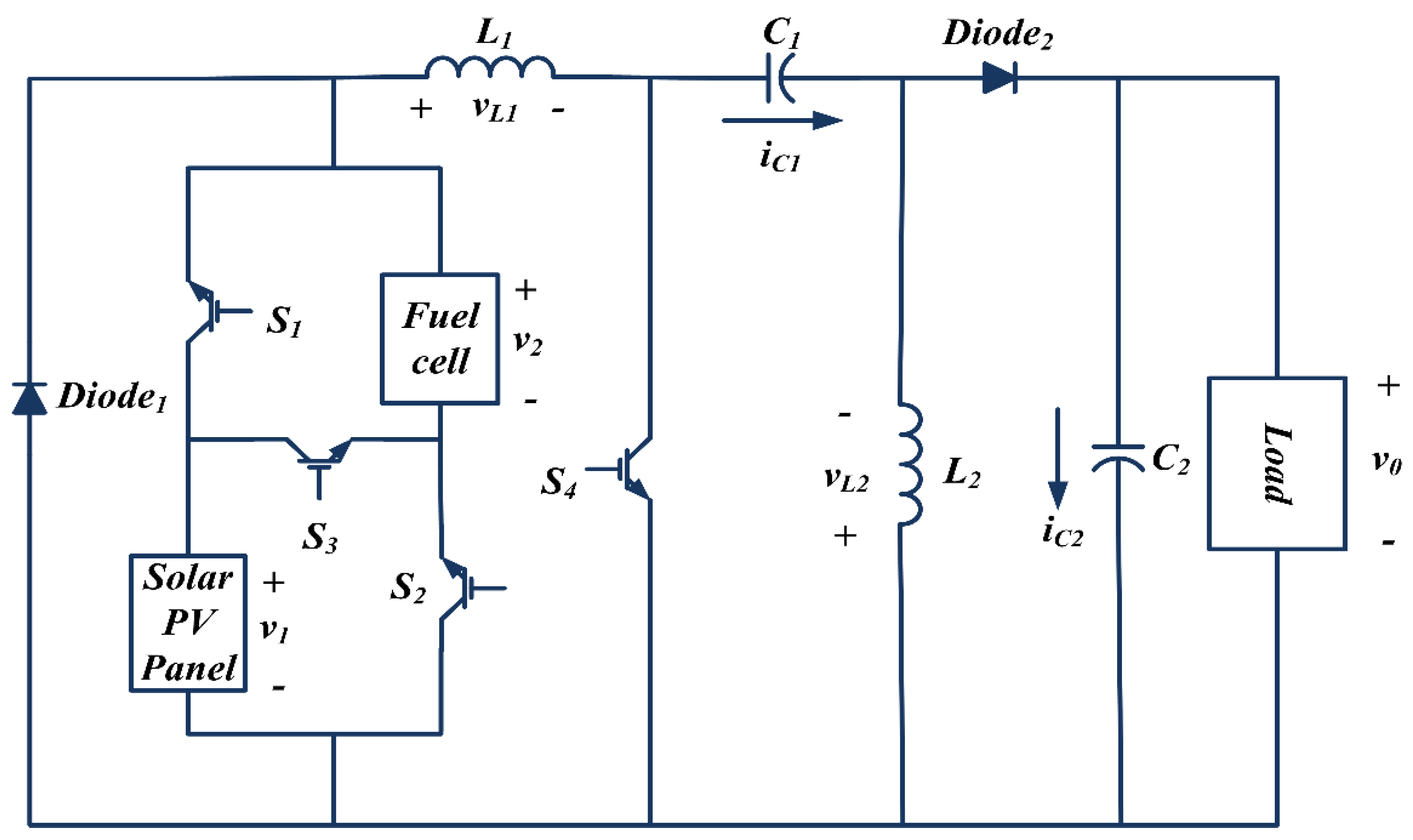

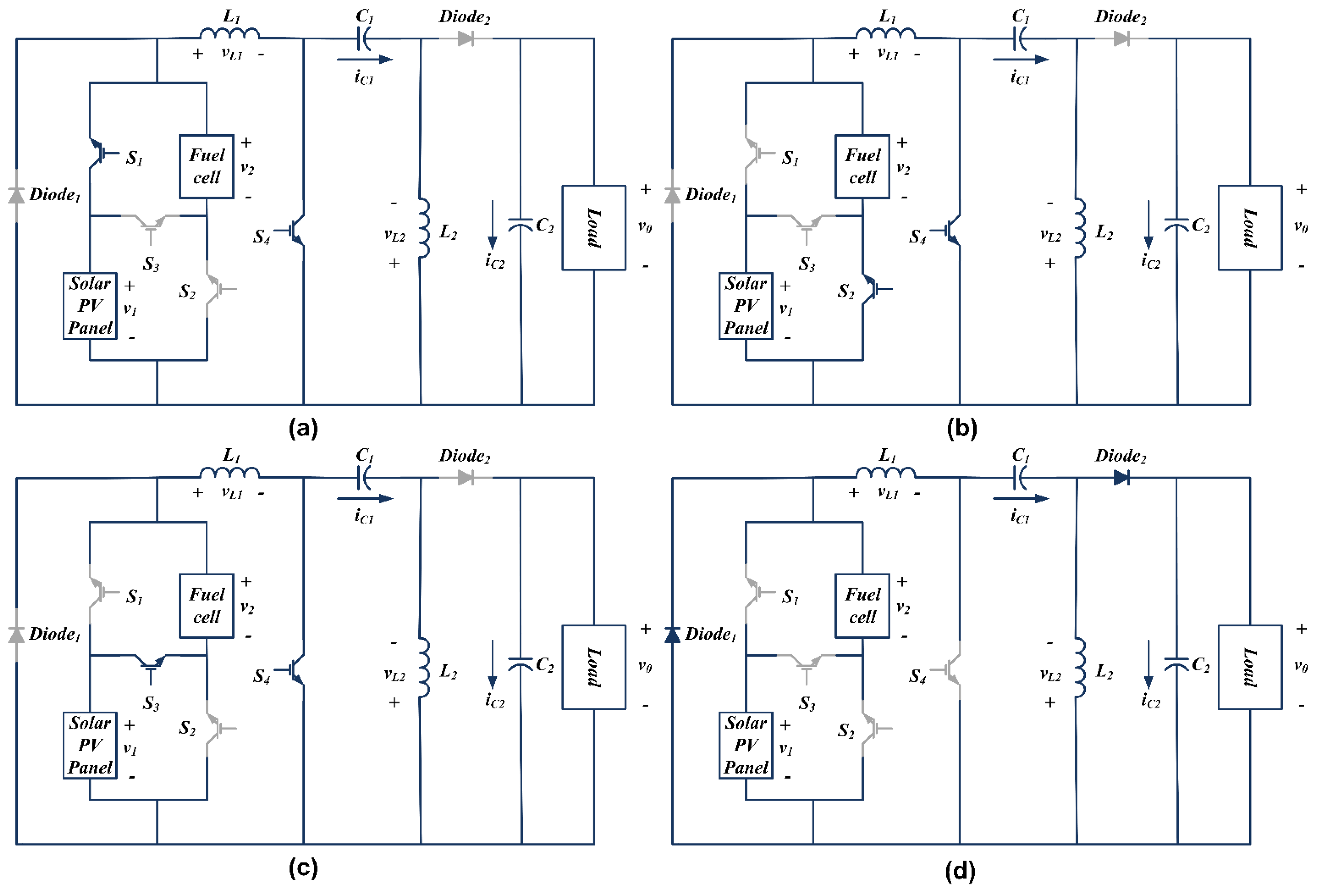

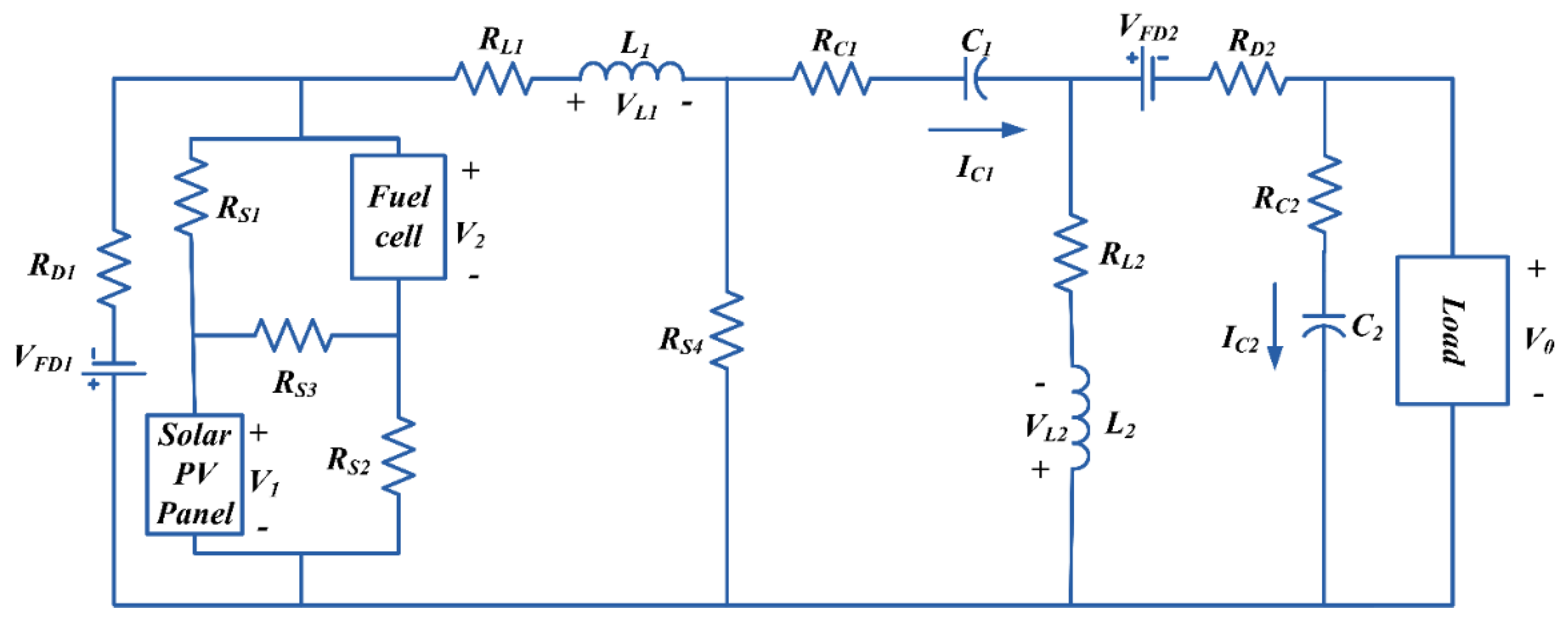

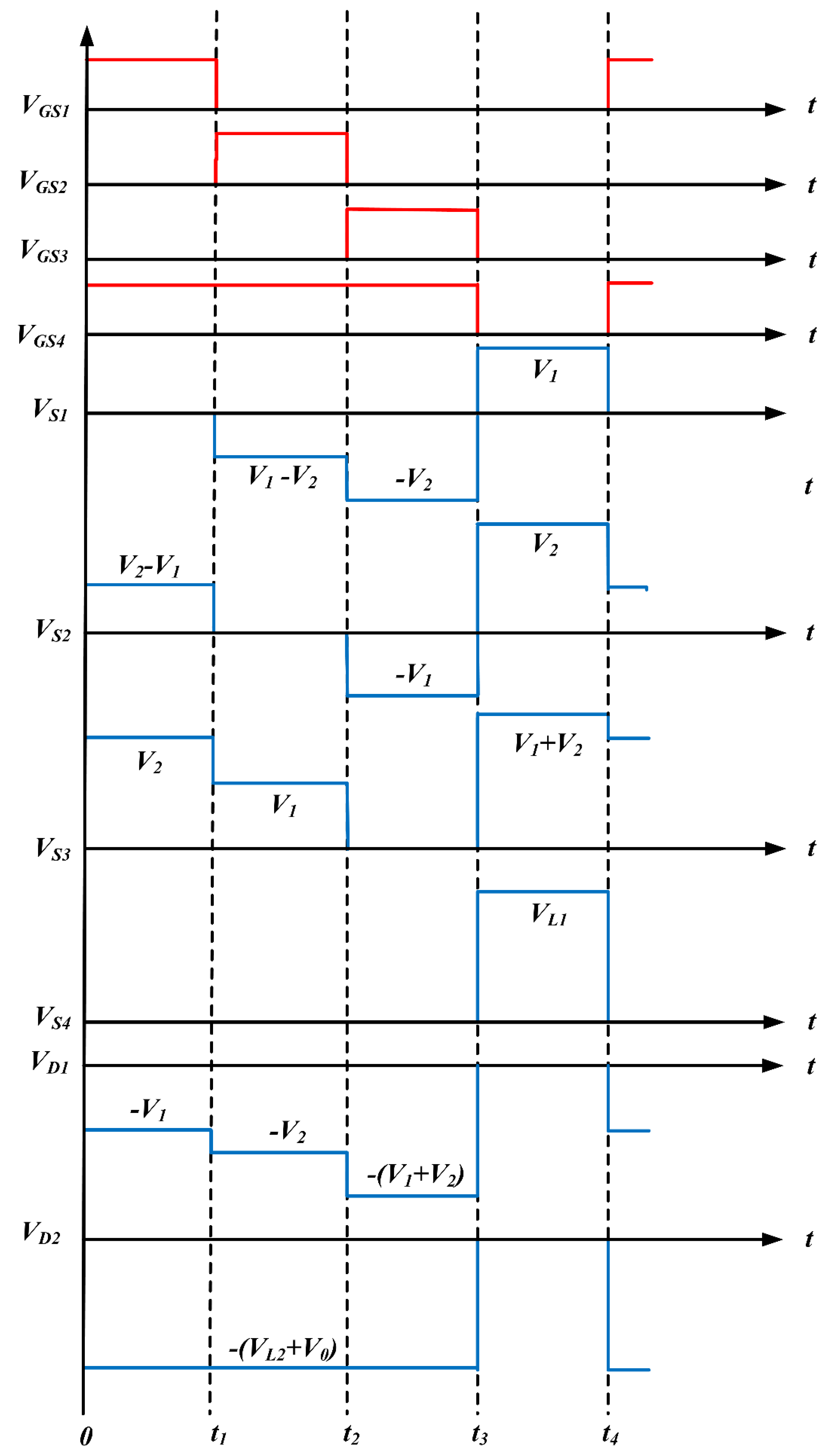
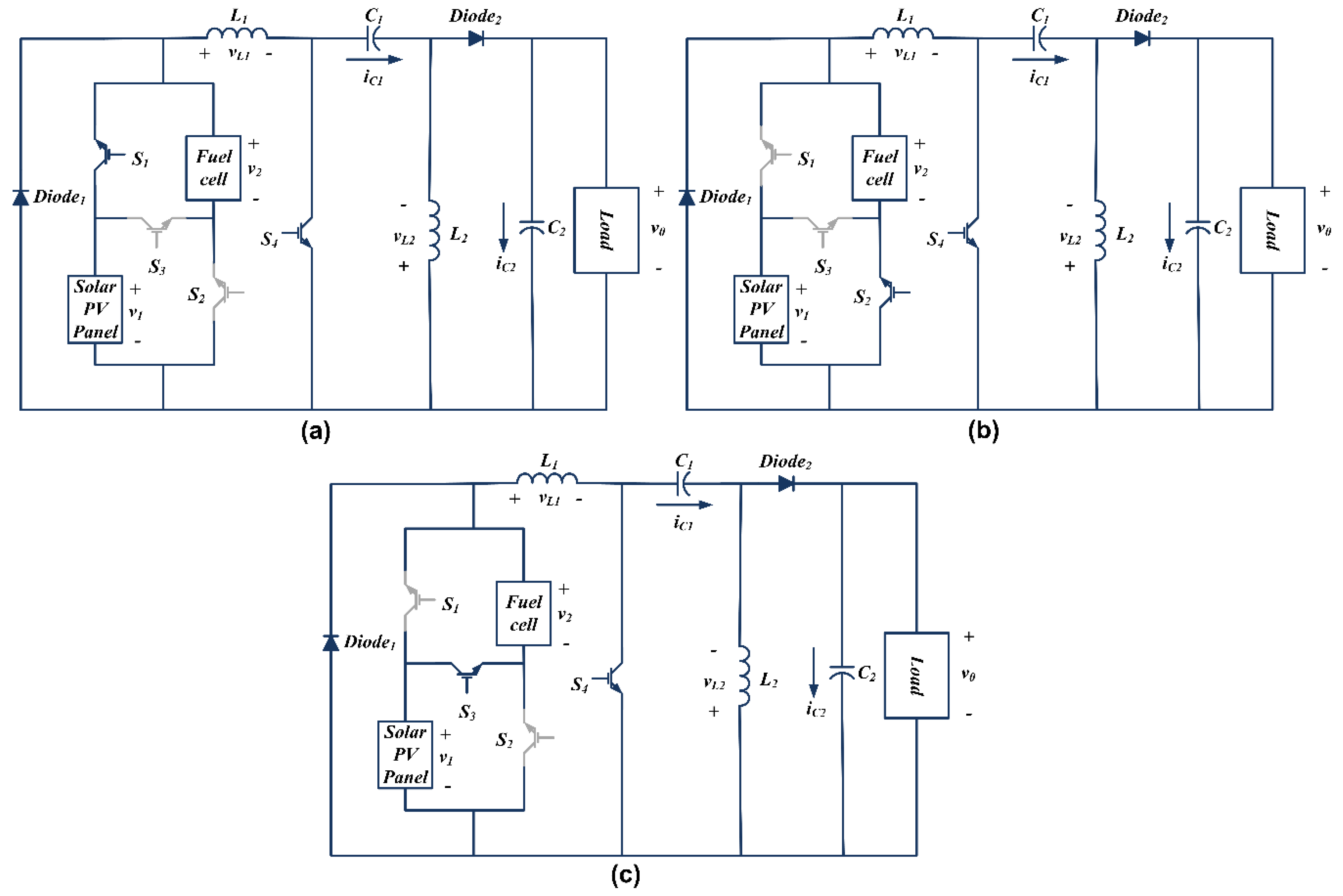
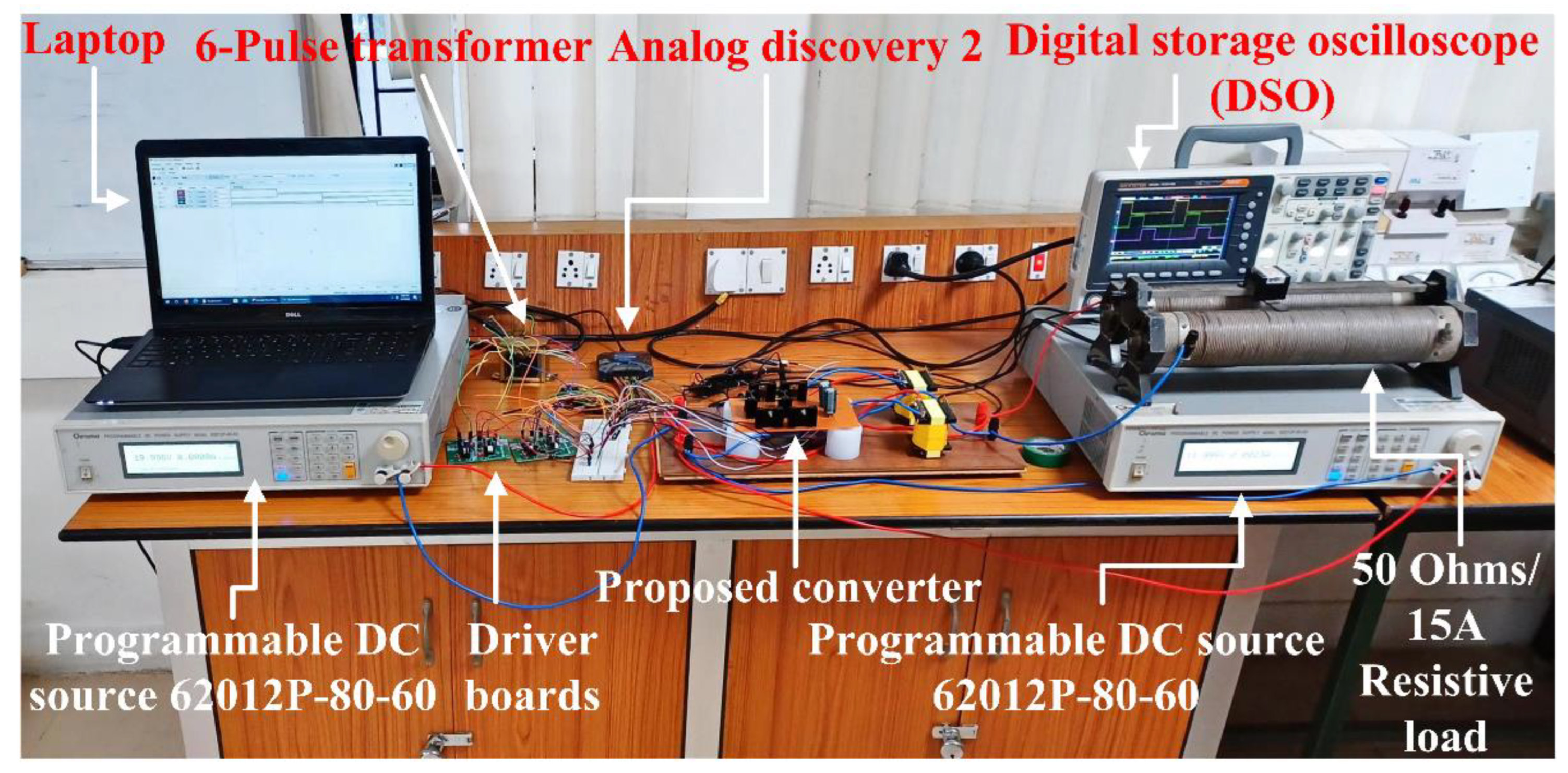



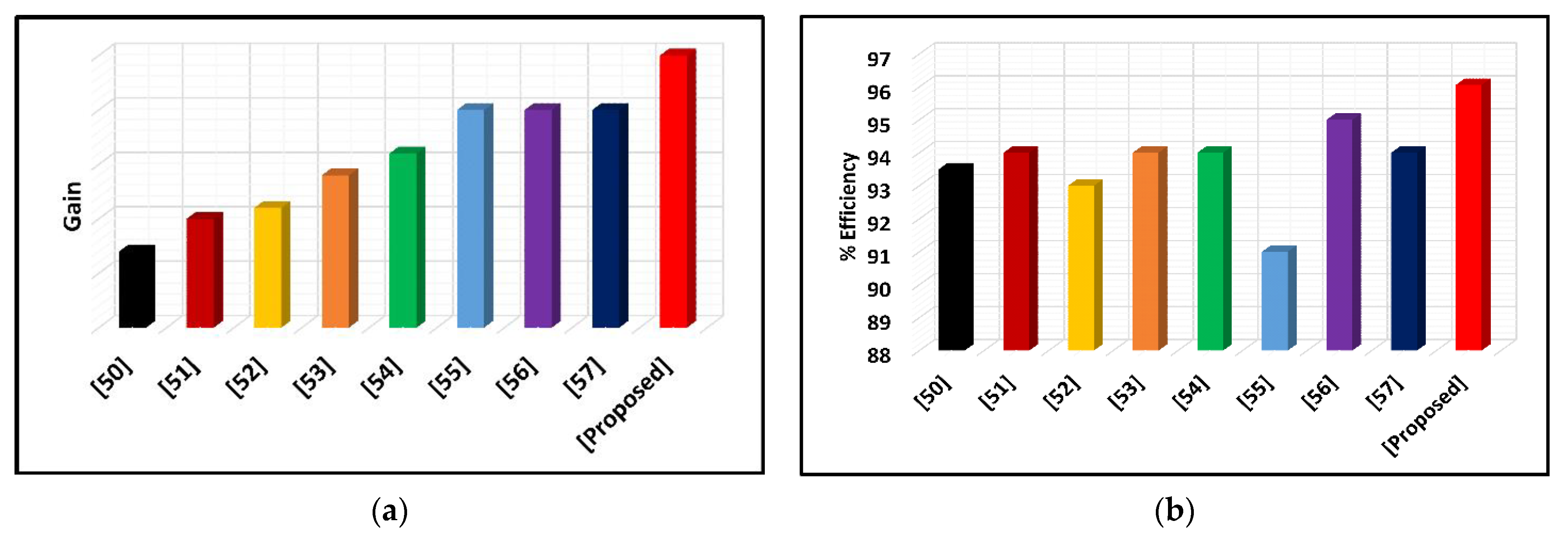
| Scenarios | Solar Panel (V1) | Fuel Cell (V2) | Action | |
|---|---|---|---|---|
| 1 | 1 | 0 | Solar PV panel alone supplying the load | |
| 2 | 0 | 1 | Fuel cell alone supplying the load | |
| 3 | 1 | 1 | Fuel cell and solar PV panel together supplying the load |
| Component | Value |
|---|---|
| Input Voltages | V |
| Output Voltage | V |
| Output Power | W |
| Switching Frequency | kHz |
| Inductors | mH |
| Capacitors | µF |
| IGBT (4) | |
| Diode (2) | |
| Load Resistance | Ω |
| Topology | Relation between Input and Output Voltages | No. of Sources | No. of Power Switches (Unidirectional) | No. of Power Switches (Bidirectional) | No. of Relays | No. of Diodes | % Efficiency | Voltage Stress | No. of Capacitors | No. of Inductors |
|---|---|---|---|---|---|---|---|---|---|---|
| [50] | 2 | 0 | 3 | 0 | 5 | 93.50 | High | 2 | 2 | |
| [51] | 2 | 4 | 0 | 4 | 3 | 94 | - | 1 | 1 | |
| [52] | 2 | 0 | 3 | 3 | 1 | 93 | - | 1 | 1 | |
| [53] | 2 | 2 | 2 | 0 | 0 | 94 | High | 1 | 1 | |
| [54] | During discharging During charging | 3 | 4 | 2 | 0 | 2 | 88–94 | Low | 1 | 1 |
| [55] | 2 | 6 | 2 | 0 | 2 | 91 | High | 4 | 4 | |
| [56] | 2 | 4 | 0 | 0 | 4 | 95 | Moderate | 4 | 4 | |
| [57] | 2 | 3 | 0 | 0 | 3 | 94 | Moderate | 3 | 3 | |
| Proposed | 2 | 4 | 0 | 0 | 2 | 96 | Low | 2 | 2 |
Publisher’s Note: MDPI stays neutral with regard to jurisdictional claims in published maps and institutional affiliations. |
© 2022 by the authors. Licensee MDPI, Basel, Switzerland. This article is an open access article distributed under the terms and conditions of the Creative Commons Attribution (CC BY) license (https://creativecommons.org/licenses/by/4.0/).
Share and Cite
Bairabathina, S.; S, B. Design and Validation of a SEPIC-Based Novel Multi-Input DC-DC Converter for Grid-Independent Hybrid Electric Vehicles. Energies 2022, 15, 5663. https://doi.org/10.3390/en15155663
Bairabathina S, S B. Design and Validation of a SEPIC-Based Novel Multi-Input DC-DC Converter for Grid-Independent Hybrid Electric Vehicles. Energies. 2022; 15(15):5663. https://doi.org/10.3390/en15155663
Chicago/Turabian StyleBairabathina, Saikumar, and Balamurugan S. 2022. "Design and Validation of a SEPIC-Based Novel Multi-Input DC-DC Converter for Grid-Independent Hybrid Electric Vehicles" Energies 15, no. 15: 5663. https://doi.org/10.3390/en15155663
APA StyleBairabathina, S., & S, B. (2022). Design and Validation of a SEPIC-Based Novel Multi-Input DC-DC Converter for Grid-Independent Hybrid Electric Vehicles. Energies, 15(15), 5663. https://doi.org/10.3390/en15155663






